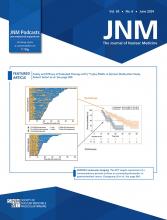JNM Editors’ Choice Awards: Johannes Czernin recognizes outstanding contributions to JNM in 2023, as selected for awards at the upcoming SNMMI Annual Meeting.
Page 825
Discussions with leaders: Frederik (Freek) J. Beekman, PhD, distinguished inventor, entrepreneur, and professor of Applied Physics at the Technische Universiteit Delft, talks with Czernin and Mona about his career in academia and industry.
Page 826
Amyloid-β, tau, and F-DOPA PET: Burkett and colleagues offer an educational overview of visual interpretation of amyloid, tau, and dopaminergic PET images; their roles in the clinical context; and potential pitfalls in interpretation.
Page 829
18F-FET PET cost-effectiveness: Rosen and colleagues report on 18F-FET PET for treatment monitoring of multimodal therapy, including checkpoint inhibitors, targeted therapies, radiotherapy, and associated combinations, in patients with brain metastases secondary to melanoma or non–small cell lung cancer.
Page 838
PET/CT in oligometastatic breast cancer: Moser and colleagues assess the impact of 18F-FDG PET/CT on the definition of oligometastatic disease and detection of metastatic patterns in breast cancer, emphasizing the importance of standardizing imaging definitions.
Page 845
Predictive metabolic response in TKI therapy: Schuler and colleagues evaluate metabolic response on 18F-FDG PET after short-course osimertinib to identify lung cancer patients with resistance to epidermal growth factor receptor tyrosine kinase inhibitors who will benefit from next-line osimertinib.
Page 851
CLDN18.2 molecular imaging in cancer: Qi and colleagues detail a first-in-human study of 68Ga-NC-BCH PET and its biodistribution, metabolism, dosimetry, safety, and potential for quantifying claudin-18 isoform 2 expression in gastrointestinal cancer patients.
Page 856
PET/MRI and methotrexate neurotoxicity: Baratto and colleagues use [18F]FDG PET/MRI to diagnose high-dose methotrexate–induced brain injury and correlate the results with cognitive impairment identified by neurocognitive testing in pediatric cancer survivors.
Page 864
68Ga-FAPI-46 in 18F-FDG–negative lung cancer: Röhrich and colleagues evaluate in lung cancer patients the diagnostic potential of static and dynamic 68Ga-FAPI-46 PET imaging in 18F-FDG–negative pulmonary lesions.
Page 872
68Ga-FAPI PET and FAP-RPT in sarcoma: Lanzafame and colleagues describe the diagnostic performance and accuracy of 68Ga-FAPI PET in patients with various bone and soft-tissue sarcomas, highlighting potential eligibility for FAP-targeted radiopharmaceutical therapy.
Page 880
FAPI PET/CT in genitourinary cancers: Hagens and colleagues conduct a systematic analysis of current literature on the utility of FAPI PET/CT for staging patients with genitourinary malignancies.
Page 888
Novel 68Ga-labeled PET/MRI in prostate cancer: Duan and colleagues assess in a phase II study the feasibility, safety, and diagnostic performance of 68Ga-NeoB and 68Ga-PSMA-R2 PET/MRI for detection of biochemically recurrent prostate cancer.
Page 897
PSMA PET/CT heterogeneity intensity score: Swiha and colleagues develop a simple, clinically applicable PSMA PET/CT score, encompassing the elements of SUVmean without additional quantification, for use in predicting response to 177Lu-PSMA therapy.
Page 904
Extended [177Lu]Lu-PSMA therapy: Seifert and colleagues investigate the safety and efficacy of extended [177Lu]Lu-PSMA radiopharmaceutical treatment in patients with metastatic castration-resistant prostate cancer who have received more than 6 cycles.
Page 909
RECIP and progression-free survival prediction: Gafita and colleagues identify associations between interim PSMA PET/CT by Response Evaluation Criteria in Prostate-Specific Membrane Antigen Imaging 1.0 and short-term outcomes after radiopharmaceutical treatment for metastatic prostate cancer.
Page 917
[177Lu]Lu-DOTATATE absorbed dose–response: Hebert and colleagues explore how postinfusion dosimetry can influence clinical management by predicting efficacy and toxicity in [177Lu]Lu-DOTATATE treatment of gastroenteropancreatic neuroendocrine tumors.
Page 923
PAH for renal protection in PRRT: Moraitis and colleagues document the safety and efficacy of para-aminohippurate coinfusion as an alternative to amino acid coinfusion during peptide receptor radiotherapy in patients with neuroendocrine tumors.
Page 931
68Ga-FAP-2286 PET tumor dosimetry: Kline and colleagues detail the imaging characteristics of 68Ga-FAP-2286, present dosimetry analysis, and compare the agent with 18F-FDG and FAPI compounds.
Page 938
Quantitative SPECT prognosis in ATTR-CM: Caobelli and colleagues analyze the predictive and risk-stratifying value of quantitative [99mTc]Tc-DPD SPECT/CT in suspected and confirmed amyloid transthyretin–related cardiomyopathy at different disease stages.
Page 944
Tau PET in 4-repeat tauopathies: Bischof and colleagues report on the development and suitability of a technique for [18F]PI-2620 PET for tracking of disease progression in patients clinically diagnosed with progressive supranuclear palsy or cortical basal syndrome.
Page 952
Human brain [18F]VAT quantification: O’Donnell and colleagues characterize the distribution of this vesicular acetylcholine transporter–specific PET tracer in the brain and optimize methods for quantification in cholinergic pathways.
Page 956
Radiomics in cervical cancer: Collarino and colleagues investigate whether radiomic features extracted from pretreatment [18F]FDG PET can improve prediction of histopathologic tumor response and survival in patients with locally advanced cervical cancer treated with neoadjuvant chemoradiotherapy and surgery.
Page 962
Bootstrapped kinetics of dynamic PET data: Wu and colleagues examine a nonparametric approach to mapping kinetic parameters and their uncertainties, using data from the emerging generation of dynamic whole-body PET/CT scanners.
Page 971
DL-based PVC: Leube and colleagues introduce, test, and validate a methodology for partial volume correction of 177Lu SPECT/CT imaging using deep learning.
Page 980
SSTR antagonists in Merkel cell cancer: Kircher and colleagues describe 68Ga-labeled somatostatin receptor antagonist PET/CT imaging in a patient with metastatic Merkel cell carcinoma and discuss the potential of SSTR antagonist imaging for peptide receptor radionuclide therapy candidate selection.
Page 988
[18F]FES-avid irradiated lung: Rich and colleagues present a case study elucidating the nature of false-positive changes on [18F]FES PET/CT after pulmonary radiation in a patient with breast cancer and demonstrate an associated finding of [18F]FES-positive draining nodes.
Page 990
- © 2024 by the Society of Nuclear Medicine and Molecular Imaging.







